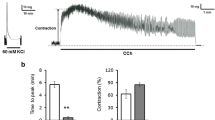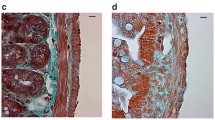Abstract
Our aim was to investigate the contribution of variations in intestinal muscle morphology or function to regional differences in motor propertiesin vivo. We quantitated intestinal muscle thickness and surface area along the canine gut and compared thein vitro contractile properties of the jejunum and ileum. The thickness and cross-sectional surface area of both circular and longitudinal muscle demonstrated a parabolic distribution along the intestine, with the greatest values occurring in the proximal and distal regions. The terminal ileum had the greatest circular (885±194 μm) and longitudinal muscle (367±135 μm) thickness. Circular muscle was 2.5–3 times thicker than longitudinal muscle at all points. Passive tension was similar in muscle strips from the mid-jejunum, mid-ileum, and terminal ileum (2.8±0.8, 2.5±0.4, and 2.3±0.8 vs 2.5±0.5, 1.9±0.5, and 2.8±1.0, longitudinal and circular, respectively). Active and total tension, however, were significantly greater in longitudinal than circular muscle in mid-jejunum (active; 8.5±1.4 vs 5.6±1.2,P<0.05 and total 11.3±1.7 vs 8.1±1.2) and in mid-ileum (active 9.5±1.6 vs 5.8±1.2 and total 12.0±1.6 vs 7.7±1.2). Values for each layer were similar in both sites. In contrast, in the terminal ileum, longitudinal and circular muscle strips demonstrated similar active (10.1±1.7 vs 9.0±2.7 NS) and total tension (12.4±2.0 vs 11.9±3.4 NS). Dose-response curves to carbachol (10−8–10−2 M) were similar in all these regions. We conclude (1) there are regional variations in muscle mass but contractile properties are similar in jejunum and ileum; and (2) the unique motor properties of the terminal ileum may be related more to differences in muscle morphology and neural input than intrinsic function.
Similar content being viewed by others
References
Quigley EMM, Phillips SF, Dent J: Distinctive patterns of interdigestive motility of the canine ileocolonic junction. Gastroenterology 87:836–844, 1984
Quigley EMM, Phillips SF, Dent J, Taylor BM: Myoelectric activity and intraluminal pressure of the canine ileocolonic sphincter. Gastroenterology 85:1054–1062, 1983
Nasmyth DG, Williams NS: Pressure characteristics of the human ileocecal region—a key to it's function. Gastroenterology 89:345–351, 1985
Quigley EMM, Thompson JS: The motor response to intestinal resection: A study of motor activity in the canine small intestine following distal resection. Gastroenterology 105:791–798, 1993
Nguyen BL, Thompson JS, Quigley EMM: Effect of extent of resection on intestinal muscle adaptation. Gastroenterology 106:A548, 1994
Pekas JC: Morphometry of the intestine of the pig. I. A method for complete circumsection analysis. Dig Dis Sci 31:79–79, 1986
Nygaard K: Resection of the small intestine in rats. III. Morphological changes in the intestinal tract. Acta Chir Scand 133:233–248, 1967
Mayhew TM, Carson FL: Mechanisms of adaptation in rat small intestine: Regional differences in quantitative morphology during normal growth and experimental hypertrophy. J Anat 164:189–200, 1989
Nowak TV, Harrington B, Weisbruch JP, Kalbfleisch JH: Structural and functional characteristics of muscle from diabetic rodent small intestine. Am J Physiol 258:G690-G698, 1990
Nowak TV, Harrington B: Effect of cholinergic agonists on muscle from rodent proximal and distal small intestine. Gastroenterology 88:1118–1125, 1985
Scott LD, DeFlora E, Weisbrodt NW, Lester R: Pregnancy, sex steroids, and contractility of rat small intestine. Gastroenterology 82:1174, 1982
Quigley EMM, Phillips SF, Cranley B, Taylor BM, Dent J: Tone of canine ileocolonic junction: Topography and response to phasic contractions. Am J Physiol 249:G350-G357, 1985
Snape WJ, Crawford B, Hyman PE, Lechago J: Anatomic contribution to differences in rabbit colonic muscle contraction. Gastroenterology 100:75–81, 1991
Sarna SK: Gastrointestinal longitudinal muscle contractions. Am J Physiol 265:G156-G164, 1993
Hammer J, Camilleri M, Phillips SF, Aggarwal A, Haddad AM: Does the ileocolonic junction differentiate between solids and liquids. Gut 34:222–226, 1993
McKurdy HC, Marshall RW, Taylor BA: Control of the human ileocecal junction: Anin vitro analysis of adrenergic and nonadrenergic non-cholinergic mechanisms. Digestion 54:200–206, 1993
Cardwell BA, Rubin MR, Snape WJ, Cohen S: Properties of the cat ileocecal sphincter muscle. Am J Physiol 241:G222-G226, 1981
Vermillion DL, Huizinga JD, Riddell RH, Collins SM: Altered small intestinal smooth muscle function in Crohn's disease. Gastroenterology 104:1692–1699, 1993
Blennerhassett MG, Vignjevic P, Vermillion DL, Collins SM: Inflammation causes hyperplasia and hypertrophy in smooth muscle of rat small intestine. Am J Physiol 262:G1041-G1046, 1992
Author information
Authors and Affiliations
Additional information
Supported by the VA Merit Review Program
Rights and permissions
About this article
Cite this article
Nguyen, B.L., Thompson, J.S. & Quigley, E.M.M. Regional variation in canine intestinal muscle mass and function. Digest Dis Sci 40, 1491–1497 (1995). https://doi.org/10.1007/BF02285197
Received:
Revised:
Accepted:
Issue Date:
DOI: https://doi.org/10.1007/BF02285197




